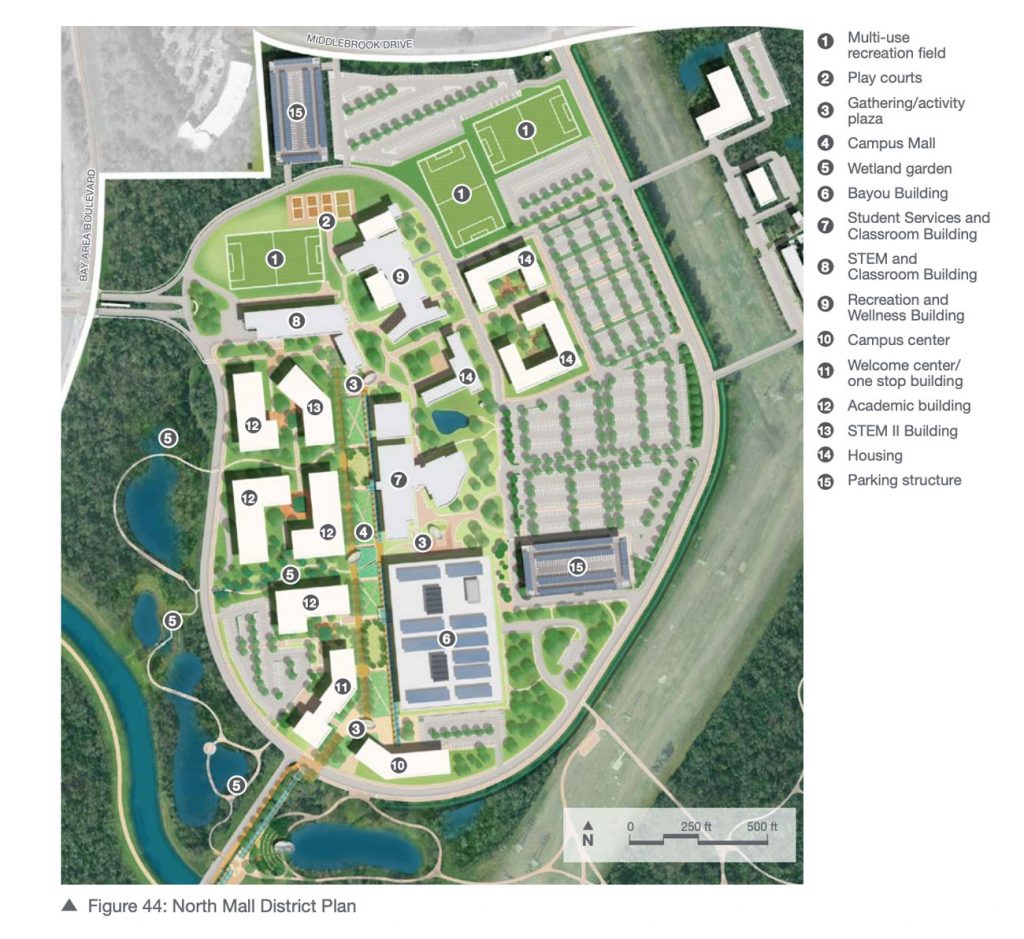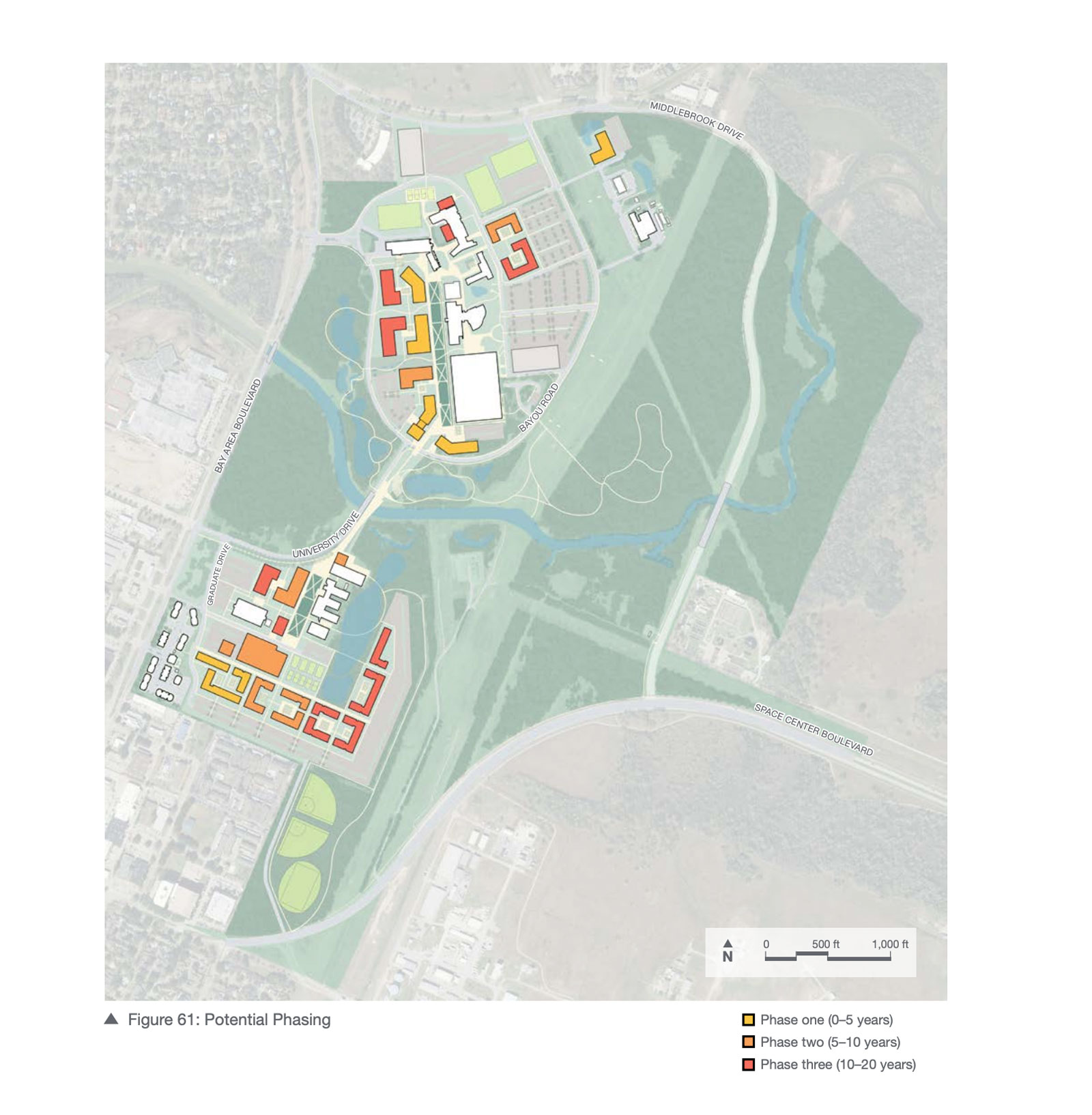
EDITORIAL: UHCL’s Master Plan to expand campus should support sustainability
As a university that strives to create solutions to present-day problems and focuses on students, the University of Houston-Clear Lake (UHCL) has drafted a master plan that will serve as a framework to physically expand as a campus. The overarching goal of the plan is to value and protect the 524-acre wildlife and nature preserve the campus is located on while supporting enrollment growth.
Since the transition from only offering upper-division classes to a four-year institution in 2014, the campus has grown to include a recent addition of an on-campus residence hall, Campus Recreation and Wellness Center, STEM classroom building, and a new health building on the Pearland campus. Campus culture is naturally expected to shift and grow with the addition of freshmen and sophomore students in the mix.
As UHCL continues to evolve into a more traditional four-year university, areas supporting campus activities and overall quality of student life will become necessary, but at what cost?
UHCL needs to prioritize protecting the nature preserve and forested areas while trying to enhance the natural habitat on campus. While the UHCL Master Plan supports sustainability, as the master plan is slowly implemented, UHCL will need to keep up with the best environmental practices to turn plans into reality.

For example, although it is stated the university should have a “forest management plan,” it is unclear whether one has been established or how stringent the university will adhere to planting native plants.
The UHCL Master Plan, current as of November 2017, was drafted after eight months of collaborative planning efforts between UHCL leadership, students, faculty and staff to define a shared rational vision for the campus and how to realize it. This resulted in four key planning principles to guide future planning: celebrate the natural environment, employ compact development strategies, enhance campus identity and visibility, and reinforce a coherent land use and development framework.
The current plan is split into three major phases, with each phase focusing on different priority projects and areas to prevent disturbances in the surrounding habitats, ecosystems and normal campus operations. Phases one and two are both slated for five years each and phase three is set for 10 years in duration, however, projects will depend on data supporting the need for their approval, such as student enrollment numbers.

Phase one concentrates on the campus center, welcome center/one-stop building, STEM II, and another academic building. UHCL should be nearing the next sequence of phase one, which is scheduled to establish the North Mall district and associated multi-level parking areas, improve parking lot D and relocate the Environmental Institute of Houston building.
The second phase was envisioned to be implemented in five to 10 years and focuses on additional housing for both lower- and upper-division students and another academic building to complete the Campus Mall in the north section. The south section is set to include a REC center and a campus life addition to the Arbor building. The remainder of student housing and three academic buildings should be completed in phase three.
While the need for expansion is logical with the addition of freshman and sophomore students on campus, as well as reaching record enrollment of 9,145 students for the 2019 fall semester, building without serious forethought could negatively impact what makes UHCL unique as part of a wildlife and nature preserve.
One of the beloved aspects of the campus is the peaceful nature surrounding it. Poorly monitored construction and development could possibly lead to UHCL’s status as a wildlife and nature preserve to be removed. Fortunately, the current Master Plan seems to take conservation seriously.
The Master Plan states the campus should be designed and developed with long-term reliance and stewardship of the university’s land resources. It also states campus development must consider the ecological and hydrological context of the site and should minimize negative impacts on the natural environment by scheduling major construction around breeding and nesting seasons.
It also says renewable energy options should be explored, such as using solar energy around campus by placing photovoltaic panels on roofs, ground arrays and parking shade structures to reduce energy consumption.
Campus development is to be guided by principles that seek to bridge the north and south cores of the campus, organize development and circulation to prioritize comfortable pedestrian movement and locate key campus life functions at the nexus of the Bayou building and the Campus Mall.
Academic and campus life buildings are to be three stories and organized to frame and define the Campus Mall while creating open spaces like courtyards and plazas. The campus development strategy emphasizes compact development to preserve as much of the forested areas near campus as possible by building up instead of out.
The Master Plan states the use of natural surface drainage and new detention areas to avoid building costly storm drains. This is supposed to help mitigate flooding by capturing the first inch of stormwater for temporary storage and water quality treatment and returning treated stormwater to the Bayou. Integrated stormwater management is proposed for parking lots, campus landscape, transition zones and natural pond management to direct the flow of water toward drainage and detention areas.
Parking and Transportation Demand Management will try to concentrate parking close to where it is most needed with five levels of structured parking. Possible strategies to reduce parking demands include providing transit, shuttle and carpooling.
Ridesharing and bicycle/pedestrian infrastructures could also lessen the need for driving on or to campus. This should alleviate the need to further disturb the nature preserve and keep as much of the forest intact as possible.
As technology and information constantly update, it is imperative UHCL continues to consider new data regarding best environmental practices, effects of on-going construction and how to provide present-day solutions to sustain a community of involved students, faculty, staff, residents and nature.
With the changes proposed, it is exciting to think about how different the campus will look 10 or 15 years from now. It feels inspiring to attend a university that actually cares and prioritizes the environment. Since its inception, UHCL has always had two distinct claims that make it unique – the partnership with NASA Johnson Space Center, and its identity as a wildlife and nature preserve.
Implementation will be crucial during any potentially harmful activities that can occur during construction, digging or deforestation. Accountability will ultimately rest on UHCL as a campus, but it will take the effort of everyone who enjoys the natural beauty on campus to call out inconsistencies or issues with the proposed Master Plan.

Deer don’t pay to park. It’s as simple as that folks. Money drives the motivations of man, while words sympathize with the bleeding hearts. 10-15 years from now the only trees will have been planted and the only deer to see will be in pictures lining the halls of a once forgotten natural habitat. I know this sounds doom and gloom but believe me this story has repeated itself through the years time and time again. So lets keep on moving forward, scrapping the grounds clean, building new buildings, so that the next generation of mans children can enroll in UHCL keeping the coffers full. Nothing personal nature, it’s only business.